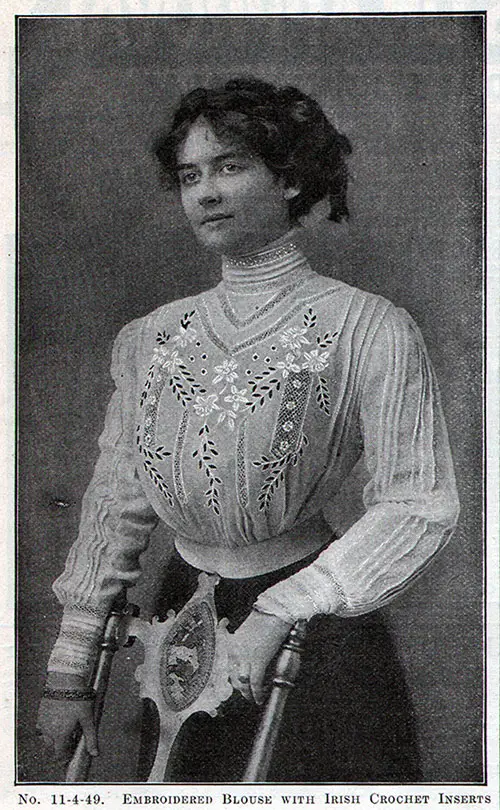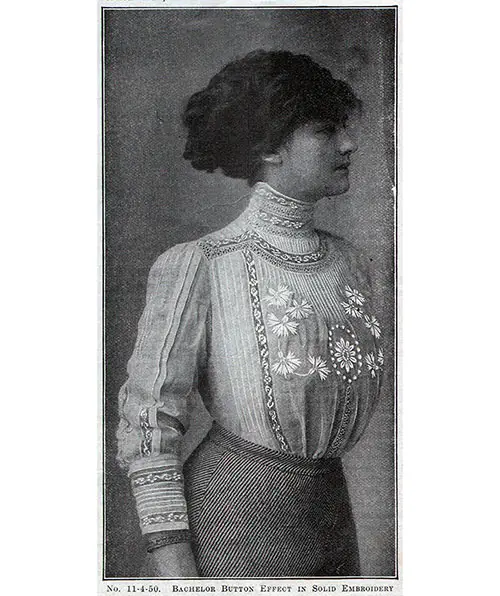Ladies Embroidered Lingerie Blouses - 1911
Described by Christine Ferry
Embroidery is quite as important a factor in the decoration of hand-made blouses as ever but is generally used In combination with lace inserts rather than by Itself, and the embroidery design is perhaps not so elaborate as heretofore.
There are a few new materials especially favored for lingerie waists this season, among them cotton voile and marquisette, but for the dressy blouse, there is, after all, nothing more satisfactory, or in better taste, than one of the fine Persian lawns, for a cotton material, and linen lawn is a regular standby.
In the make-up of one of these elegant blouses, the first thing to be considered is the embroidery, which is done upon the flat material before setting in the lace insertions or doing other needlework.
It will be a surprise to many to learn that much of the most exquisite French embroidery is done with the material held in the hand or basted on a backing of heavy paper or oilcloth, such as used in lace-making, rather than being put into a frame.
A small hoop should never be used for an elaborate design, as it is necessary to move it often, and the marks of the hoop pressure do not improve the appearance of either embroidery or fabric.
Both the designs shown on this page are typically Parisian in conception and execution.
The flower forms are all rather large, and even though done in solid satin-stitch embroidery the effect is not extensive, as the stitches are seldom laid 'across the full width of the petal, from outline to outline, but only to the center, where a tiny line of material will be left to represent the veining.
This not only adds to the appearance of the flower but makes the embroidery much more substantial and practical. This voiding, as it is called, is generally carried only from the center midway the length of the petal, the upper part being worked directly across the width in the usual manner.

No. 11.4-49. Embroidered Blouse with Irish Crochet Inserts
The large flowers of the upper design. No. 11-4-49, have one and sometimes two Incisions at the base of each petal to break the width.
The oval dots, which represent the stamens and anthers, are done in padded satin-stitch laid crosswise the width of the motif, and the three large leaves in the center of the design are worked in slanting satin-stitch from the edge to the center vein, where a tiny line of fabric is left.
In contrast with so much heavy embroidery, the sprays of leaves done in eyelet embroidery produce a most charming effect and should be very carefully worked to keep their shape.
Irish crochet insertion is used in combination with the embroidery. There is much of this popular lace seen on both waists and gowns 'this season. If lace insertion is to be used, one will make no mistake in selecting Irish.
Two different widths are used on this waist, the narrow consisting merely of the bébe Irish mesh, and the wider introducing small roses.
A very appropriate way of inserting the Irish crochet lace Is to work along the edge with a fine buttonhole-stitch, the purl coming on the side next to the lace, after which the fabric may be cut away from under with little likelihood of fraying. This finish is very much in keeping with the lace.
The insertion is necessarily rather expensive if one buys it, as it is hand-made, but anyone who can wield a crochet hook can easily copy the simple picot mesh, and it will make a beautiful pick-up work.
When one can do so it is a good plan to make the insertion in strips of the exact length required, as when crochet is cut it is very likely to ravel unless special care Is taken to fasten the ends.
As one works, the insertion can be rolled into a little ball and put into a tiny bag of silk or cotton to keep from becoming soiled. Many pretty patterns for these inserts are given in the Priscilla Irish Crochet Book, the price of which is 25 cents.

No. 11-4-50. Bachelor Button Effect in Solid Embroidery
The second waist. No. 11-4-50 is charming. A simple flower motif is embroidered on the front, and clusters of fine hand-run tucks and lace insertion of two different types of lace combine in creating a waist which is sufficiently dainty and dressy to please the most exacting.
The bachelor button is an excellent motif for solid embroidery, as it is large enough to be useful and at the same time can be treated so that it need not be heavy.
Each petal is worked directly across the width of the lower part, and at the tip is divided into three sections. Tile calyx is divided into two parts by working from the edge to the center, voiding as previously described.
The petals of the sizeable star-shaped flower in the center front are also voided excepting at the tips, where the stitches are laid across from edge to edge.
The circle of tiny dots in the center of this flower is done in satin-stitch, as are also the larger dots surrounding it, and the stitch direction should be the same on all, that is, it should follow the path of an imaginary line forming the circumference of the circle.
When the embroidery is completed the upper part of the waist is run with fine tucks, graduated in length to accommodate themselves to the embroidery. Space is left for a row of insertion and then a cluster of tucks laid to the waistline. When this is done the rows of lace insertion are put in.
Illustrations
No. 11.4-49. Embroidered Blouse with Irish Crochet Inserts Transfer pattern, 15 cents. Perforated stamping pattern, 30 cents. Stamping paste, with directions, 10 and 25 cents a box. Design stamped on white linen, linen lawn or batiste, $2.50; on cotton lawn, $1.25. Cotton for working, 8 cents.
No. 11-4-50. Bachelor Button Effect in Solid Embroidery Transfer pattern, 15 cents. Perforated stamping pattern, 30 cents. Stamped on white linen, linen lawn or batiste, $2.50; on cotton lawn, $1.25. Cotton, white or one preferred color, for working, 10 cents, or silk for working, 40 cents.
Work commenced on any one piece, 75 cents additional.
Ferry, Christine, “Two Handsome Lingerie Blouses,” in The Modern Priscilla, Vol. XXV, No. 2, Boston, The Priscilla Publishing Co., April 1911, p. 33.
Note: We have edited this text to correct grammatical errors and improve word choice to clarify the article for today’s readers. Changes made are typically minor, and we often left passive text “as is.” Those who need to quote the article directly should verify any changes by reviewing the original material.

